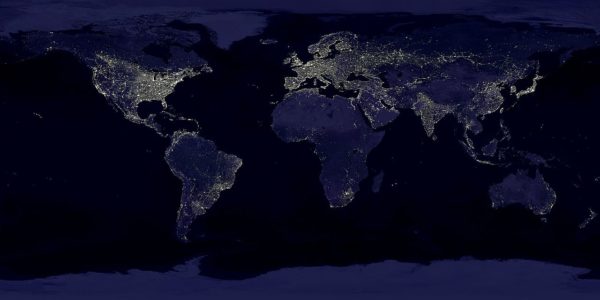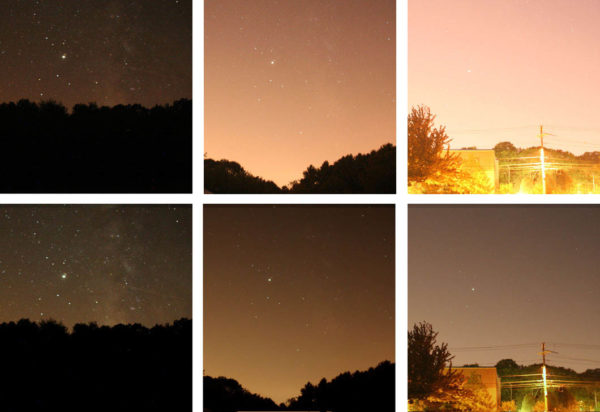"Before we devised artificial lights and atmospheric pollution and modern forms of nocturnal entertainment we watched the stars. There were practical calendar reasons of course but there was more to it than that. Even today the most jaded city dweller can be unexpectedly moved upon encountering a clear night sky studded with thousands of twinkling stars. When it happens to me after all these years it still takes my breath away." -Carl Sagan
For all of human history, we’ve battled against the limitations of our bodies and the natural world. That’s led to the development of artificial lighting: from fire to modern electric and LED lights. Despite being able to see our surroundings much more clearly at all hours regardless of the Moon or the clouds, we’ve also lost something spectacular: the night skies themselves.
 A composite image of the Earth at night, with data from 1994/1995. Image credit: Craig Mayhew and Robert Simmon, NASA GSFC, with data from Marc Imhoff of NASA GSFC and Christopher Elvidge of NOAA NGDC.
A composite image of the Earth at night, with data from 1994/1995. Image credit: Craig Mayhew and Robert Simmon, NASA GSFC, with data from Marc Imhoff of NASA GSFC and Christopher Elvidge of NOAA NGDC.
There are thousands of stars visible to the naked eye from a truly dark-sky location, yet such places are increasingly harder to come by. East of the Mississippi in the United States, they barely exist at all. From many urban locations, even bright, easily recognizable sights like the North Star or the Big Dipper are no longer visible.
 What a digital camera (top) and the human eye (bottom) sees from dark sky locations rating a 4, 6 and 9 on the Bortle scale, respectively. Image credit: Tony Flanders of Cloudy Nights, via http://www.cloudynights.com/topic/306632-illustrated-with-real-images-b….
What a digital camera (top) and the human eye (bottom) sees from dark sky locations rating a 4, 6 and 9 on the Bortle scale, respectively. Image credit: Tony Flanders of Cloudy Nights, via http://www.cloudynights.com/topic/306632-illustrated-with-real-images-b….

I live in the suburban eastern seaboard. This time of year we can see the constellation Orion and maybe 5-10 other stars on a good night, but that's about it. I think that puts us at about a 8 on the scale?
It's not too bad to be slightly light polluted, eric. If you're in really dark skies, it's hard to work out which stars are supposed to be the constellation. When sky brightness limits you to mag 4 stars, it's a hell of a lot easier to pick out the brightest ones in a constellation-y figure.
good place to mention
http://darksky.org/idsp/finder/
I'm at a slightly better location then eric, but not by much. Good thing is that I can get decent night skies at some 20-30km drive. Not great, but ok enough. But wow is correct.. when I go out.. I can't find anything with just looking up, have to use software because you're litteraly lost in a sea of stars :)
Hmmm. "Oh my god. It's full of stars!"?
LOL!
TBH, it's a good thing to be in a suburban sky with a GOTO Scope. The lack of stars with the eye helps alignment and once aligned, there's no real problem with the light polluton except for deep sky objects that are faint (I've seen most of the Triangulum with binoculars twice from my suburban back garden, and that not very well), and the fainter stars.
E.g. if the light is bright enough to dim 4th magnitude stars, you will lose three magnitudes from the optimal claims of the telescope (so if it manages 12th Mag, you can get away with 9th, which is still a heck of a lot of stars....).
Oh, another thing you can do to make the DSL images better is to drop a few stops and expand the exposure time.
It dims the diffuse background more than the point brightness of the stars.
Won't help (much) with extended objects, since they will be cut by stopping down the shutter too. It depends on whether it's effectively a point object or not, for the bit you're wanting to see. E.g. ring nebula when unresolved is still a point object and will darken less than the background if you stop down, but if it is extended in the image, you have to filter the image, else you are dimming both the background and the object.
My place is probably similar to Sinisa's. I verify Wow's observation, one night we went up to a dark site in the Sierra, and it was difficult to find my way around.
From my house I never could find triangulum (with a 12inch Dob). Once I thought I found a slightly brighter patch of sky with the binocs, which was probably a detection? But, that was years back, its much worse now. Other than M-31 all galaxies are only tiny cores (the galactic nuclei tend to be bright enough). truly disappointing.....
The bino observation was on extremely good seeing nights with binoculars resting on my eyes while looking straight up and lying down on a lounger, reducing the wobble of they binoculars. Because triangulum is such a fainy object, and still really quite large, it is VERY difficult to get a large scope to see it visually. At f5 you would need a 25mm EP to get the exit pupil to ~5mm for the dark adapted eye (lower magnifications do not increase brightness because some of the light falls onto the iris rather than into the eye. And a 12 inch dob at f5 and a super plossl 25mm EP is less than 1 degree FOV, and if you're off by half a degree, triangulum is at least partly out of the view,
Bins are really the only option. Photographically, as long as you have accurate pointing, you can use a bigger diameter to shorten the exposure times.
When I was in high school, I lived in the Santa Ynez valley of California (inland on the other side of the mountains from Santa Barbara). The high desert air got cold even on a spring or summer night and you could see quite a bit even without equipment. Having a Dyson telescope made it even better though. The best viewing was on a clear night on the top of mount Figueroa, you could often meet up with astronomy groups from the entire county...the narrow lane hairpin turns in the dark were the only downside...but the view was worth it.
Sure you didn't mean Dobson?
:)
The dyson scope sucks...
Yep, same conclusion ....
Here's a global map with a light pollution overlay:
http://djlorenz.github.io/astronomy/lp2006/overlay/dark.html
Now that you mention it, not sure which is was. The optical tube was made of some kind of painted red industrial cardboard tube, like what they use as a mold to make cement columns with, and the base it sat on was made of painted black plywood with castors on the bottom so you could move the thing around carefully, it was huge, not at all portable.
.
After looking around online, I think it was a Dobson. It looked a lot like this:
https://en.wikipedia.org/wiki/Dobsonian_telescope
Your description is that of a Dob. Dyson do not make telescopes per se; only telescopic suction tubes for their vacs.
:)